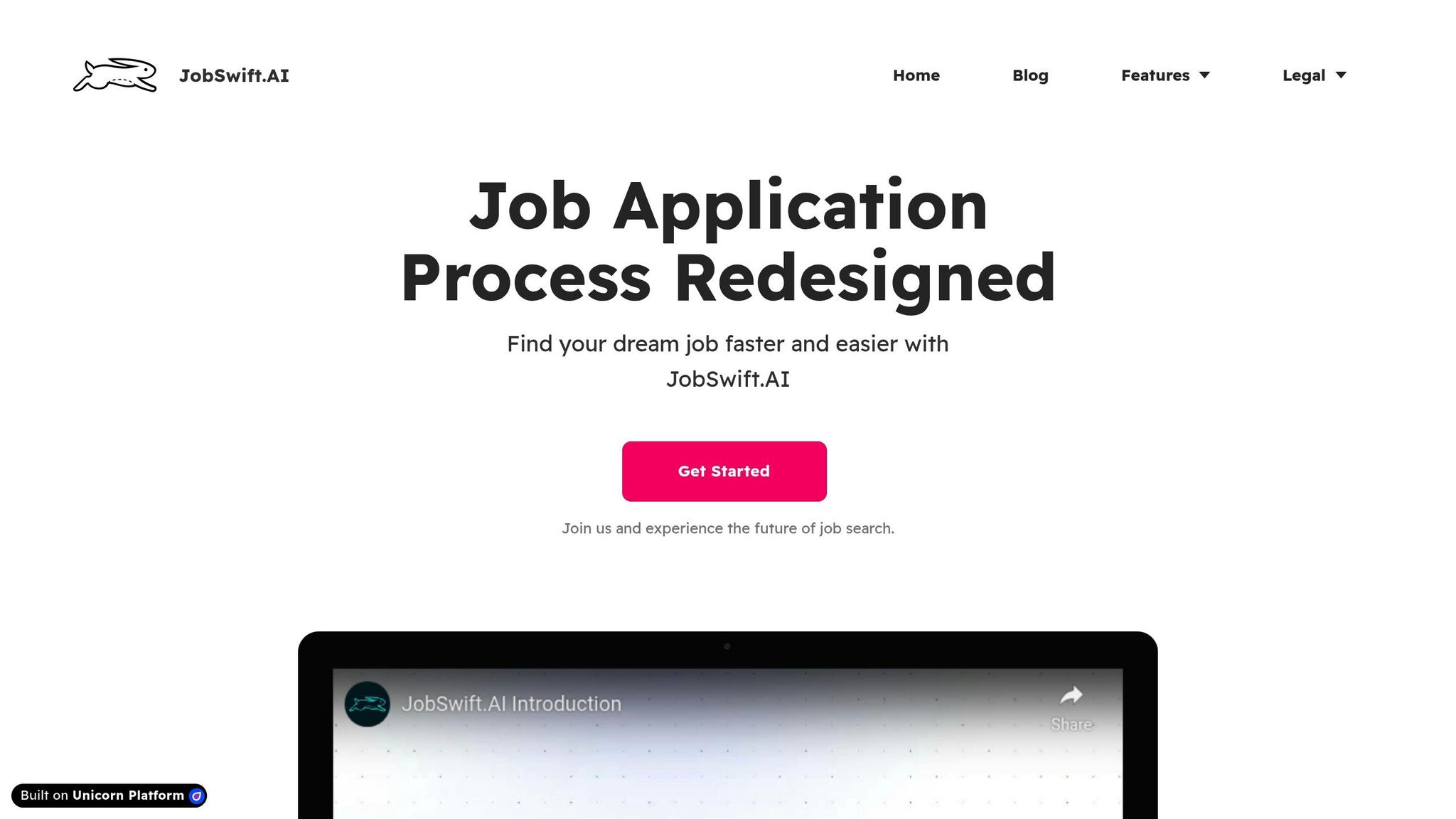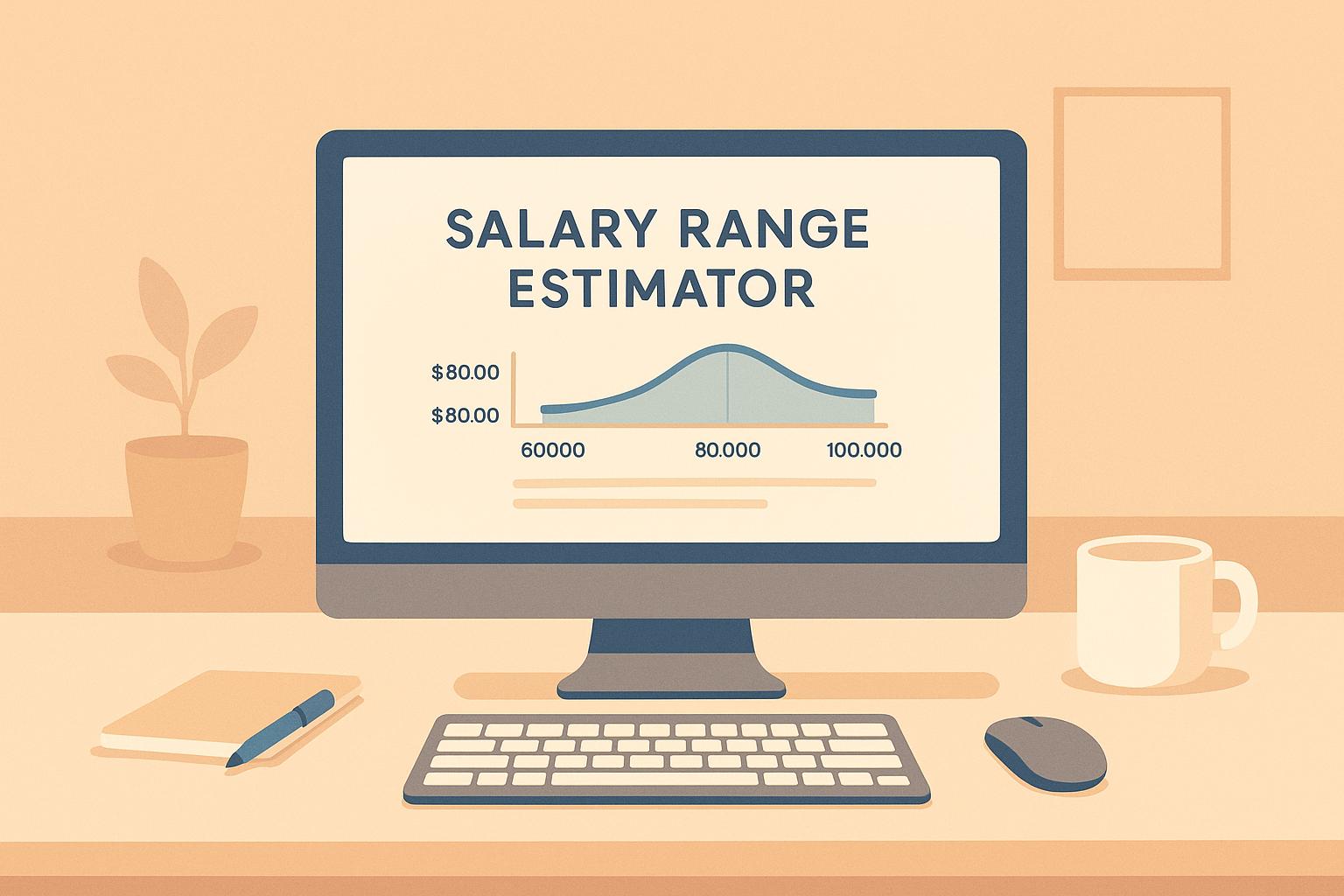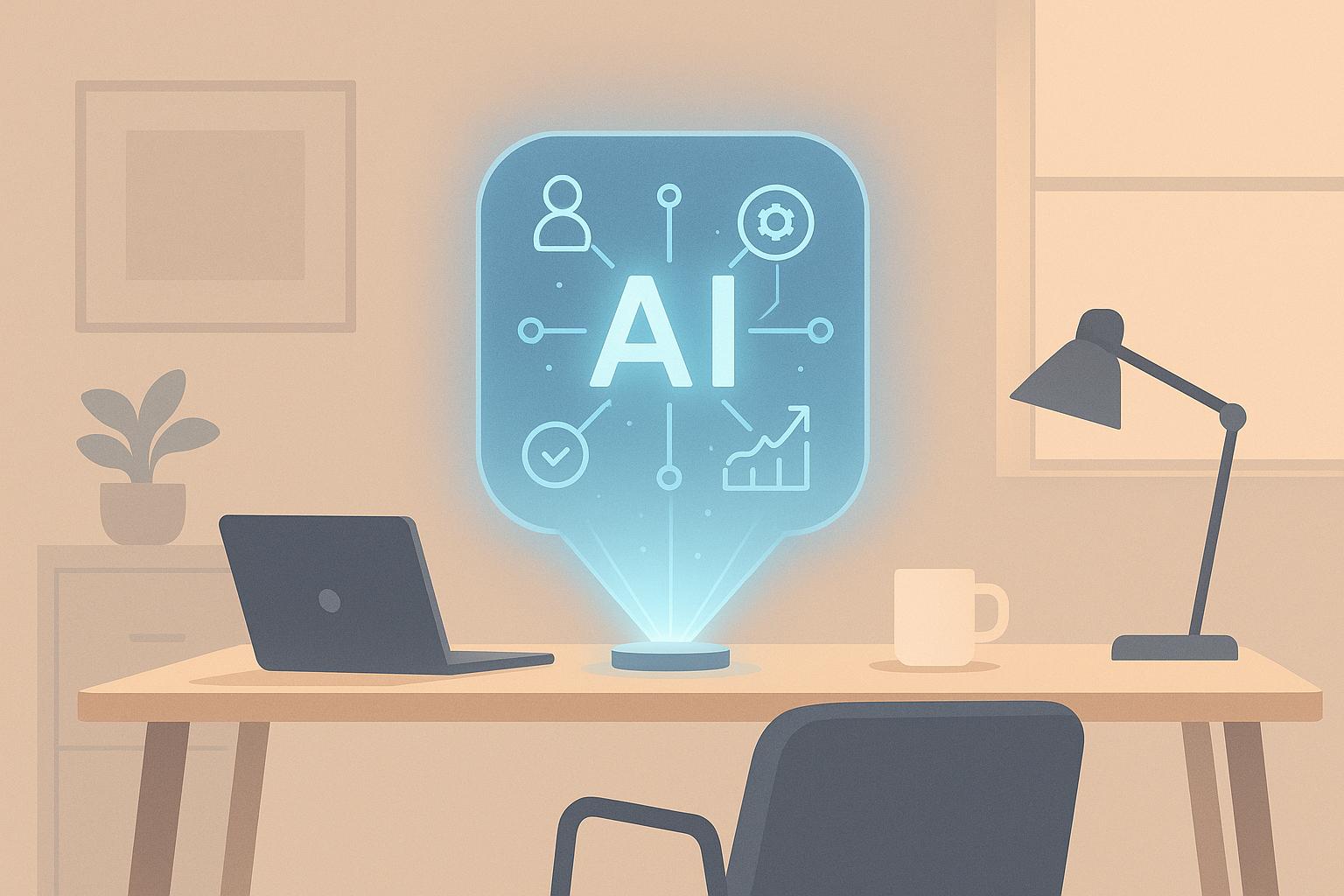AI is reshaping how hiring works. Instead of relying on resumes and quick interviews, companies now use tools that analyze data to match candidates with jobs more effectively. These systems look at everything from work history to personality traits and even online habits to predict how well someone might perform in a role. Here's how AI recruitment works:
- Data Collection: AI reviews resumes, applications, and even public profiles to gather a complete picture of the candidate.
- Criteria Mapping: It compares this data to job requirements and company values, identifying potential matches - even for skills not explicitly listed.
- Fit Scoring: AI assigns scores based on skills, experience, and alignment with the job, helping recruiters prioritize candidates.
- Human Review: Recruiters make the final call, using AI insights to guide decisions.
AI speeds up hiring, reduces bias, and helps find better matches, but it's not perfect. It requires regular checks to avoid reinforcing past biases and ensure decisions align with hiring laws. The key is combining AI's efficiency with human judgment for better results.
Build AI Agent to Match Best Candidates for a Job Description | AI powered Candidate Matching
Core Components of AI-Driven Fit Analysis
AI-powered recruitment tools are reshaping how employers evaluate candidates. By combining advanced technologies, these systems go beyond traditional hiring methods, offering a more nuanced understanding of a candidate's potential for success and alignment with company values. Let’s break down the key components that make this possible.
Data-Driven Candidate Assessment
At the heart of AI recruitment lies data-driven assessments, which form the foundation of candidate evaluation. Using natural language processing, AI scans resumes with precision, identifying patterns like consistent employment history, relevant certifications, and specific project experience.
But AI doesn’t stop there. It fills in gaps by cross-referencing information from various sources, ensuring that qualified candidates aren’t overlooked due to incomplete resumes. For example, if a candidate’s resume doesn’t explicitly list a required skill but their work history suggests relevant experience, AI can flag them for further review.
AI also streamlines pre-screening through chatbots. These bots verify essential qualifications, such as a CDL license or OSHA-10 certification, saving recruiters significant time and effort. Once these foundational checks are complete, the focus shifts to evaluating less tangible qualities like soft skills and workplace compatibility.
Behavioral and Personality Analysis
Assessing soft skills and cultural alignment requires looking beyond the resume. AI employs tools like psychometric tests, interactive chatbots, and gamified scenarios to evaluate these critical factors.
Video interviews are another powerful tool. Using sight and speech recognition technologies, AI analyzes nonverbal cues - body language, facial expressions, and vocal tone - to gain insights into personality traits and workplace behavior. For instance, a candidate’s tone during an interview might suggest confidence, while their body language could indicate adaptability.
AI also examines a candidate’s digital footprint for additional clues. For example, someone actively engaging with motivational content might demonstrate a growth mindset, while participation in professional forums or fitness apps could reflect self-efficacy. Even language patterns in social media posts can reveal traits like optimism, resilience, or problem-solving skills.
With these insights in hand, AI systems use predictive analytics to determine how well a candidate fits the role and the company.
Predictive Analytics for Fit Scoring
Machine learning models take historical hiring data and turn it into actionable predictions about a candidate’s future performance and likelihood of staying with the company. For example, these models can identify traits that have historically led to success in specific roles or environments.
AI can also infer a candidate’s technical skills through their online behavior. Browsing habits, such as frequent visits to sites focused on advanced programming or engagement with coding challenges, can highlight expertise that might not be immediately apparent in formal qualifications.
Finally, scoring algorithms bring everything together. These models integrate data from multiple sources - demographics, behavioral insights, psychographic profiles (like interests and values), and even digital habits - to produce a comprehensive fit score. This metric provides a detailed assessment of both technical skills and alignment with company culture.
How AI Analyzes Candidate-Employer Fit: Step-by-Step Process
AI systems take raw candidate data and transform it into actionable insights for hiring decisions. This process unfolds in four key steps, each building on the previous to deliver a well-rounded evaluation of how well a candidate aligns with a specific job and company. Let’s break it down.
Step 1: Data Collection
The journey begins when candidates submit their applications. AI systems analyze resumes to extract structured information like work experience, education, technical skills, and certifications.
But it doesn’t stop there. These systems also gather data from application forms, pre-screening assessments, and even chatbot interactions during the application process. They also capture metadata - details like the time of submission, the device used, and how long a candidate spent on different sections.
For candidates who consent, AI may also review publicly available professional profiles or portfolios. This additional layer of information helps create a fuller picture of the candidate’s expertise and professional background.
Step 2: Criteria Mapping
Once the data is collected, the AI system compares it to the job’s specific requirements and the company’s culture. Using semantic analysis, the system goes beyond simple keyword matching to identify related skills and transferable experience.
At the same time, the AI evaluates cultural compatibility. It analyzes language patterns, career decisions, and stated preferences to see how they align with the company’s work style, communication norms, and values.
The system also performs a gap analysis, identifying areas where a candidate might not meet certain requirements. However, it doesn’t stop at pointing out gaps - it also flags growth potential or alternative qualifications that could make up for those shortcomings.
Step 3: Fit Scoring and Ranking
Next, the AI system transforms all this information into measurable scores. Machine learning algorithms assign weighted scores to different factors, like technical skills, experience, and cultural alignment. These weights are customized based on the job’s priorities and past hiring successes.
For technical fit, the system evaluates hard skills, expertise, and relevant experience. Cultural fit scores, meanwhile, are based on personality traits, communication styles, and predicted behaviors. The result is an overall fit score, along with detailed breakdowns that show where a candidate excels or where they might need development.
The system also generates risk assessment scores, estimating things like retention potential, performance capability, and how quickly the candidate might adapt during onboarding. These insights help recruiters focus on candidates who are not only qualified but also likely to thrive in the role.
Step 4: Human Review and Final Decision
Even with all this advanced analysis, human judgment plays a critical role in the final hiring decisions. Recruiters receive AI-generated rankings and detailed explanations of the scores, helping them understand the reasoning behind each recommendation.
At this stage, human reviewers check for potential biases, consider team dynamics, and evaluate other contextual factors the AI might overlook. They can tweak the weightings, adjust scores, or even request additional information if something doesn’t add up.
This collaboration between AI and human expertise ensures that hiring decisions are both data-driven and thoughtful. Recruiters can balance algorithmic insights with their own understanding of cultural nuances, team chemistry, and strategic needs.
JobSwift.AI is a great example of how AI and human judgment work together to streamline hiring. It not only helps recruiters find the best candidates but also empowers job seekers to position themselves for roles that match their skills and aspirations.
Benefits and Drawbacks of AI-Powered Fit Analysis
AI-powered recruitment is transforming hiring processes by using data-driven insights to evaluate candidate fit. It automates repetitive tasks, provides tailored candidate interactions, and helps organizations make faster, more informed decisions. Let’s dive into how AI improves recruitment while also addressing some of its potential challenges.
Benefits of AI in Recruitment
Speed and Efficiency
AI can sift through thousands of resumes in minutes, significantly reducing time-to-hire. This allows recruiters to focus on high-value activities, like connecting with top candidates and nurturing relationships. Faster processing also means better alignment between candidates and employers.
Improved Candidate Matching
Machine learning algorithms analyze historical hiring data to pinpoint traits of successful employees. This insight helps recruiters make better hiring choices, improving the overall quality of new hires.
Bias Reduction
AI tools can strip away identifying details - like names and photos - that might trigger unconscious bias, focusing instead on skills, experience, and qualifications. These tools can also flag biased language in job descriptions, encouraging more inclusive hiring practices.
Enhanced Candidate Experience
AI systems personalize the hiring journey by recommending roles that match an applicant’s profile, answering their questions, and guiding them through the application process. This not only improves the candidate’s experience but also strengthens the employer’s brand.
Scalability
During busy hiring periods or rapid company growth, AI platforms can handle large application volumes without requiring additional resources. This makes them especially valuable for scaling recruitment efforts efficiently.
While these benefits streamline recruitment, AI isn’t without its flaws.
Drawbacks of AI in Recruitment
Overreliance on Data and Hidden Biases
AI systems are only as unbiased as the data they’re trained on. If historical hiring data contains biases, those biases can be reinforced, potentially excluding qualified candidates who don’t fit past patterns. Relying too heavily on algorithms can also overshadow the human judgment needed for more nuanced decisions.
Reduced Transparency
AI algorithms often function as "black boxes", meaning their decision-making processes are hard to interpret. This lack of clarity can complicate compliance with hiring regulations and make it difficult to provide meaningful feedback to candidates.
sbb-itb-96bfd48
Best Practices for Using AI in Recruitment
When blending data-driven analysis with human oversight, it's essential to follow specific practices to refine your recruitment process. By striking the right balance between automation and human judgment, organizations can tap into AI's potential while steering clear of hiring mistakes or legal troubles.
Regular Auditing for Bias and Accuracy
Set Up Monthly Reviews
Run monthly audits to check for biases across different demographics. If certain groups consistently score lower, flag these patterns and adjust the algorithms. Keep thorough documentation of findings and changes to ensure transparency.
Test with Varied Data
Evaluate your AI using profiles from diverse industries, educational backgrounds, and career paths. This helps prevent the system from favoring overly narrow criteria. Perform these tests quarterly, especially after updates or changes to job requirements.
Monitor Key Metrics
Track metrics like time-to-hire, candidate satisfaction, and retention rates. If you notice a decline, revisit the AI's criteria and make adjustments. Maintaining detailed records of these metrics allows you to identify patterns and make informed improvements.
Ensure Legal Compliance
Verify that AI-driven decisions align with EEOC guidelines and local hiring laws. This includes reviewing the system's prioritized questions to ensure they focus on job performance rather than protected characteristics.
By combining audit results with human insight, you can fine-tune your AI’s performance for better outcomes.
Combining AI with Human Expertise
AI for Screening, Humans for Final Decisions
Allow AI to handle the initial screening of applications, but leave the final hiring decisions to human recruiters. This method combines AI's efficiency with the nuanced judgment humans bring to assessing soft skills and team fit.
Train Recruiters on AI Insights
Equip recruiters with the skills to interpret AI-generated scores and recommendations. They should understand the factors influencing these scores and know when to override them based on context or additional information.
Establish Feedback Loops
Create feedback systems where recruiters can input outcomes back into the AI. For instance, if a highly ranked candidate underperforms or a lower-ranked candidate excels, feeding this data into the system helps refine future predictions.
Keep Human Interaction in the Process
Ensure candidates have opportunities to interact with real people. This personal touch not only strengthens your employer brand but also allows you to assess qualities that AI might miss.
A thoughtful combination of AI tools and human expertise ensures a more effective and balanced recruitment process.
Using Platforms like JobSwift.AI

Platforms like JobSwift.AI can enhance efficiency and fairness in hiring by offering a range of helpful features.
Comprehensive Tracking Systems
Platforms with robust tracking systems reduce administrative burden. For example, JobSwift.AI automates job application status tracking, ensuring clear communication and preventing qualified candidates from being overlooked.
AI-Driven Employer Insights
Leverage AI to gain insights into company culture, hiring trends, and candidate preferences. This data helps recruiters fine-tune their strategies to attract top talent more effectively.
Scam Protection Features
Use scam detection tools to filter out fraudulent applications, especially when hiring for high-volume or remote roles. This ensures the integrity of your candidate pool.
Simplify the Application Process
Streamline applications with features like autofill and dashboards. JobSwift.AI's autofill tools, for instance, help candidates complete forms more quickly, improving their experience.
Integrate CV Optimization
Plan for AI-driven CV optimization to align resumes with job requirements. This makes it easier for both AI systems and human recruiters to identify the best candidates efficiently.
The real power of AI in recruitment lies in using it as a tool to support human decision-making, not replace it. By maintaining this balance and committing to regular audits and updates, organizations can maximize the benefits of AI while ensuring fairness and accuracy in their hiring processes.
Conclusion
AI is transforming the way companies approach recruitment, offering a level of accuracy and efficiency that was previously out of reach. Instead of relying solely on intuition or time-consuming manual processes, businesses can now leverage data-driven insights to predict job performance and align candidates with company values.
By streamlining evaluations, AI helps reduce hiring errors and highlights exceptional talent that might otherwise go unnoticed in traditional hiring methods.
The most effective strategies treat AI as a supportive tool that enhances - rather than replaces - human judgment. This balance combines the speed of automated systems with the depth of human insight, creating a more thorough and thoughtful recruitment process.
For businesses considering AI-driven hiring solutions, the focus should be on platforms that combine robust functionality with transparent practices. Tools like JobSwift.AI excel at simplifying application management, tracking candidates, and delivering actionable insights for employers.
As organizations continue to refine these systems with regular evaluations and maintain a strong human presence in decision-making, they will unlock AI’s potential to build stronger, more cohesive teams.
The future of hiring lies in blending human expertise with AI’s precision to make smarter, faster, and fairer recruitment decisions.
FAQs
How does AI make the hiring process fairer and less biased?
AI plays a key role in making recruitment processes more equitable by emphasizing objective data and job-relevant skills, reducing the influence of unconscious biases tied to factors like race, gender, or age. By standardizing tasks such as resume screening and interview assessments, AI ensures candidates are evaluated with consistency and fairness.
However, achieving this fairness requires thoughtful design and ongoing oversight of AI systems to prevent them from perpetuating biases already present in the data. When used responsibly, AI can create a hiring process that is more inclusive, benefiting both employers and job seekers alike.
What challenges might arise when using AI to evaluate candidates during recruitment?
Challenges of Using AI in Recruitment
AI undeniably brings valuable tools to the recruitment process, but it’s not without its hurdles. One major issue is algorithmic bias. AI systems are only as unbiased as the data they’re trained on, which means they can unintentionally carry over existing biases. This can lead to unfair evaluations, creating concerns about equity and fairness.
Another challenge lies in the lack of transparency. Some AI algorithms operate as "black boxes", where the decision-making process is unclear. This lack of clarity can erode trust among both candidates and employers, as it’s hard to understand why certain decisions are made.
There’s also the loss of human connection to consider. Relying too heavily on AI can make the hiring process feel impersonal, potentially overlooking important qualities like soft skills or how well a candidate might align with a company’s values.
Finally, data privacy and compliance are pressing issues. AI-driven recruitment tools often handle sensitive personal information, raising valid questions about how this data is collected, stored, and managed in accordance with privacy regulations. These concerns highlight the need for careful oversight when integrating AI into hiring practices.
How can companies effectively combine AI tools and human judgment to make better hiring decisions?
To improve hiring decisions, companies can use AI tools for tasks like screening resumes, ranking candidates, and scheduling interviews. These tools are great at analyzing large amounts of data to pinpoint candidates with the right skills and experience. Plus, they can help speed up the hiring process and make it more efficient.
That said, human judgment is still critical for assessing qualities like empathy, leadership potential, and whether someone will gel with the team - areas where AI falls short. By combining AI's data-driven precision with the human touch for evaluating more subtle traits, companies can create a well-rounded hiring process that inspires trust and supports long-term growth.


